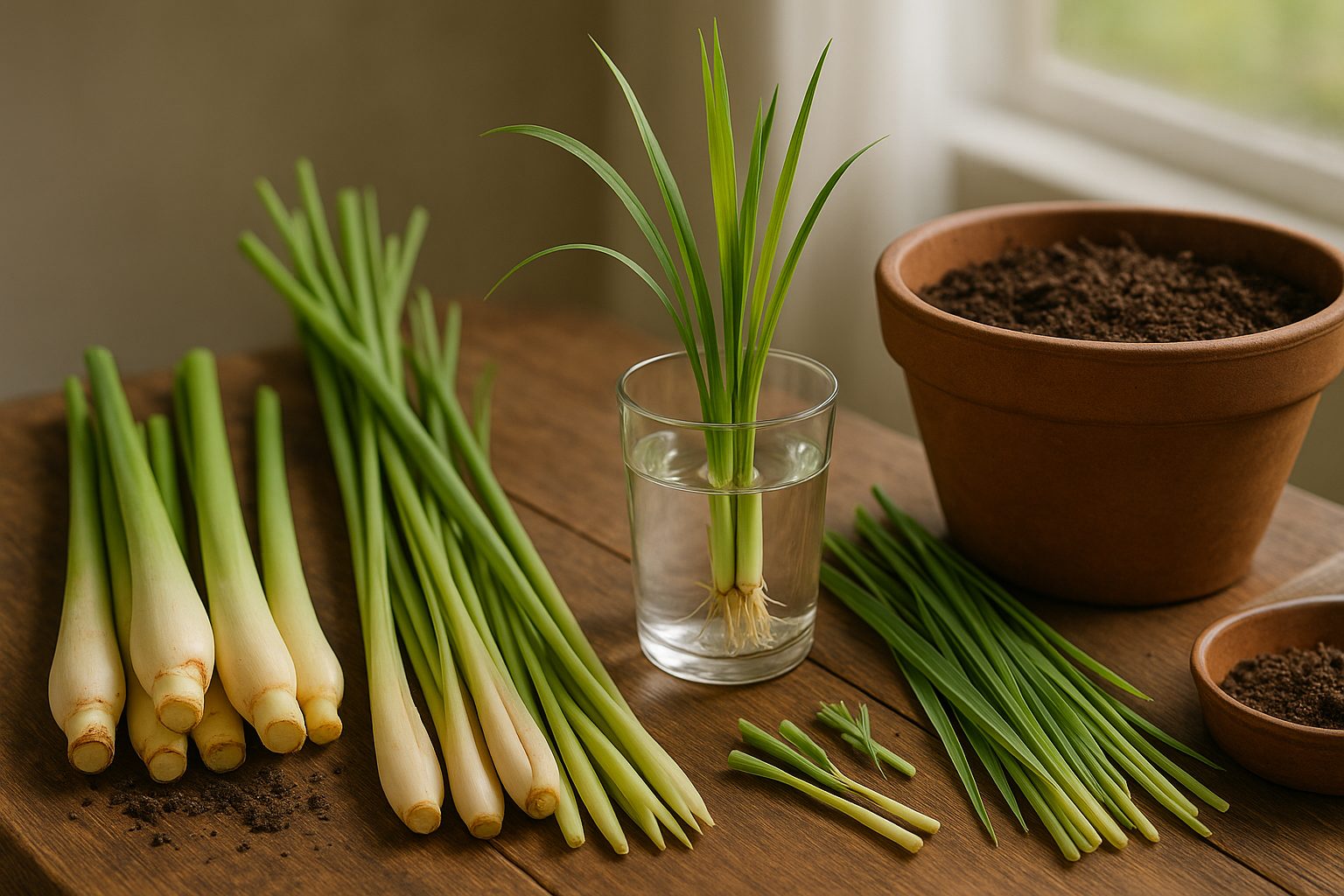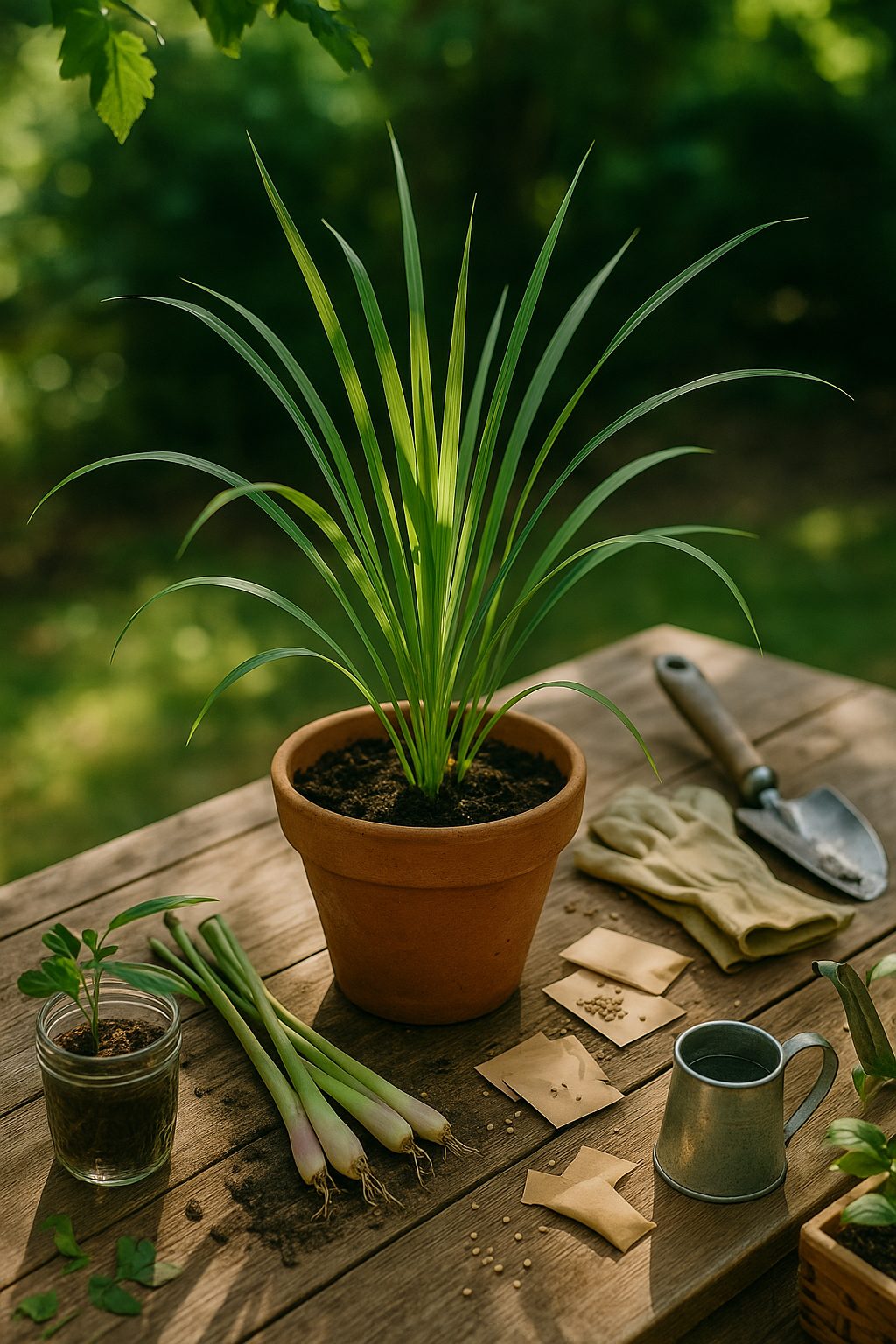Introduction to Lemongrass & Its Benefits
Lemongrass in pots has become a popular choice for home gardeners who want fresh, aromatic herbs without needing much space. Lemongrass, a tall, grassy plant native to tropical regions, is loved for its distinctive lemony flavor and bright, citrusy scent. You’ll find it starring in Asian cuisine—from fragrant Thai soups to tangy Vietnamese marinades.
But its appeal goes far beyond the kitchen; lemongrass is also valued in herbal teas, natural remedies for digestion and inflammation, and as a mosquito repellent thanks to its essential oils. Growing lemongrass in pots means you don’t need a garden bed—just a sunny window or balcony will do.
This versatile herb thrives both indoors and outdoors, making it perfect for city dwellers. It’s known for being fuss-free: it sprouts quickly from stalks bought at the grocery store and rewards you with lush, decorative foliage. With just a little care and regular watering, you’ll enjoy a harvest of fresh leaves for cooking or wellness all year round.
Whether you’re a beginner or a seasoned gardener, adding lemongrass to your potted collection brings a taste of the tropics right into your home, along with its many culinary and health benefits.
Choosing the Right Lemongrass & Growing Method

When starting your own lemongrass, you’ll usually encounter two main types: East Indian lemongrass (Cymbopogon flexuosus), preferred for culinary use, and West Indian lemongrass (Cymbopogon citratus), which is more common in global cuisine and typically easier to cultivate at home.
As for getting started, you have a few choices—growing from seeds, rooting fresh market stalks, or buying a potted plant. Seeds can be fun but slow and sometimes unpredictable; beginners may find better success rooting sturdy stalks bought from a grocery store or Asian market. Look for stalks with a thick base and some visible roots or “nubs”—these are the best candidates for successful propagation. Potted plants from nurseries are the fastest way to get established lemongrass, though they do cost a bit more upfront.
Once rooted, you can grow lemongrass in garden beds if you have space and warm weather, as the plant loves full sun and rich, well-draining soil. If yard space is limited, containers work beautifully and allow for easy relocation as seasons change—choose a deep pot to let the roots stretch out. For those in cooler climates, growing lemongrass indoors near a sunny window keeps fresh stalks within arm’s reach year-round.
No matter your approach, remember to water regularly and trim off old outer leaves to encourage new growth. Starting lemongrass is surprisingly easy once you have the right stalks and a sunny spot to help it thrive.
Preparing for Planting
Getting your garden ready for planting starts with careful site selection and soil preparation. Choose a spot that gets at least 6–8 hours of sunlight a day, as most veggies and flowers thrive in full sun. If you’re gardening in pots, place them where they can soak up enough rays.
Next, assess your soil by digging a small hole and feeling the texture—good garden soil should be crumbly and drain water easily. If water pools on the surface, improve drainage by mixing in compost or sand. Raised beds are another great option, especially if your in-ground soil is heavy clay or sandy, because you control the mix and drainage.
Pick pots with drainage holes to avoid root rot—avoid reusing old pots without cleaning them first to prevent disease. Most plants prefer temperatures between 60°F and 75°F, although this varies by type, and a humidity level that isn’t too high or low. Try not to plant right after heavy rain or during a dry spell.
Before you get started, gather your essentials:
- A shovel or trowel
- Quality potting mix or compost
- Gloves
- Watering can or hose
- Garden labels
- Fertilizer (if needed)
- Your seeds or seedlings
Having everything on hand makes planting day smoother and ensures your plants have the best start possible.
How to Plant Lemongrass (Stalks, Seeds, Pots & Ground)

Planting lemongrass is surprisingly simple, and you have several options depending on your space and resources.
If you’re starting from stalks (often sold in grocery stores), select firm, healthy pieces with the base intact. Place them upright in a glass of water on a sunny windowsill, changing the water every few days. After about two weeks, you’ll see roots and new green shoots—once the roots reach an inch long, you can transplant them.
For garden beds, loosen the soil, mix in compost, and plant the rooted stalks about 2 feet apart to allow for their bushy growth.
If planting in pots, pick containers at least 12 inches deep with drainage holes, and fill them with rich potting mix.
Seeds should be sown shallowly in moist seed-starting soil indoors, covered lightly, and kept warm and bright. Once seedlings are a few inches tall and the weather is reliably above 50°F, you can transplant them outdoors or into larger indoor pots.
If you buy a potted lemongrass plant, gently tease apart clustered stalks to give each more space when replanting in the ground or a bigger pot.
For urban gardeners with balconies or windowsills, compact cultivars or smaller clumps grow well in pots, and even a deep window box can support a stalk or two.
Early on, keep the soil consistently moist but not soggy, and mist foliage to boost humidity indoors. Lemongrass hates the cold, so if frost threatens, bring pots inside or cover them with cloches or row covers outside.
With these steps and a bit of sun, you’ll have aromatic lemongrass ready for harvest in no time.
Lemongrass Plant Care Essentials
Caring for your lemongrass plant starts with getting the watering routine just right—lemongrass likes consistently moist soil, but sitting in soggy conditions can quickly lead to root rot. Aim to water whenever the top inch of soil becomes dry, especially during hot summer days. Always let excess water drain away.
If planting in the ground or a pot, make sure the soil drains well and containers have holes at the base. For robust growth, use a balanced, all-purpose liquid fertilizer twice a month during the active growing season, typically late spring through early autumn. Organic options like fish emulsion or compost tea can also give your plant a boost without harsh chemicals.
Lemongrass thrives best in full sun—at least six hours per day—and prefers warm temperatures above 60°F (15°C). If you’re in a cooler climate or moving your plant outdoors, gradually acclimate it to the sunlight to avoid leaf scorch, and bring pots indoors if nighttime temperatures dip below 40°F (4°C).
When facing heat waves, help your plant cope by applying mulch to retain moisture and providing temporary afternoon shade.
Pruning and Dividing
To encourage bushier lemongrass, regularly prune by snipping off the outer stalks for cooking or trimming back leggy growth. This helps the plant channel energy into new shoots. Every couple of years, divide crowded clumps in spring—just dig up the root ball, gently separate sections with healthy roots and shoots, and replant them. This not only keeps your plant manageable but also invigorates its growth.
With a little attention and these simple routines, your lemongrass will reward you with lush, fragrant stalks all season long.
Harvesting & Using Lemongrass
For the best flavor, harvest lemongrass stalks once they’re about a half-inch thick and at least a foot tall—usually several months after planting. Use a sharp knife to cut the stalks close to the ground, selecting the outer, mature ones and leaving the smaller inner shoots to keep growing.
Trim away the tough, woody tops and outer leaves, saving the tender, pale inner stalk for cooking. Fresh stalks can be wrapped in a damp paper towel and stored in the fridge for up to two weeks, or chopped and frozen in airtight containers for longer shelf life.
To use, gently smash the stalk with the back of a knife to release its citrusy aroma before adding it to soups, curries, stir-fries, or marinades. For a soothing tea, slice a stalk into pieces, steep them in hot water, and add honey or ginger as desired.
Lemongrass is also handy in natural remedies—try simmering a few stalks to make a refreshing, aromatic steam inhalation for stuffy noses or infusing oil for a fragrant massage. With a little prep, lemongrass easily elevates both recipes and home wellness routines.
Troubleshooting: Common Problems, Pests & Diseases
When growing lemongrass, watch for early warning signs like yellowing leaves, wilted stalks, or stunted growth—these often point to overwatering, poor drainage, or nutrient deficiencies.
For yellow leaves, check that your soil drains well, as soggy roots can cause rot. Wilting in hot weather might just mean your lemongrass needs a deeper soak; however, persistent wilting could indicate root rot or fungal issues. If your plants seem slow to grow, try feeding them with a balanced organic fertilizer and ensure they get plenty of sunlight.
Common pests include aphids, spider mites, and leafhoppers, which can cause discolored spots or sticky residue on the leaves. Combat these naturally by spraying plants with a mix of water and mild soap or introducing beneficial insects such as ladybugs.
Watch for fungal diseases like rust, which appears as orange-brown spots on leaves; trim off affected foliage and increase airflow by spacing plants properly.
Prevent most problems by keeping your garden tidy—remove plant debris and weeds that harbor pests and disease. Water early in the day to allow foliage to dry, and always water at the base rather than from above to minimize fungal risks. Rotate crops if you’ve had issues before, and mulch around stems to suppress weeds and retain steady soil moisture.
Regularly inspect your lemongrass so you can tackle any issue early, keeping your plants vigorous, aromatic, and harvest-ready.
Final Tips & Encouragement for New Growers
Starting your lemongrass garden can be both rewarding and surprisingly simple, especially if you keep a few key tips in mind: choose a sunny spot, use well-draining soil, water consistently but avoid waterlogged roots, and trim plants regularly to encourage lush growth. Don’t be afraid to experiment—lemongrass is forgiving and can thrive in pots or in-ground beds, making it great for beginners.
Try starting with a few stalks from the grocery store or local nursery, and pay attention to how your plant responds to its environment. Most importantly, enjoy the journey; gardening is as much about the process as it is about the result.
If you hit a snag or want to learn more, online gardening forums, local extension services, and social media groups offer endless advice and support from fellow growers. Every plant you nurture is a learning opportunity—so dig in, have fun, and watch your lemongrass (and your skills) flourish.
